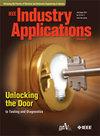Estimation of Flux Saturation Model for SynRMs Using Artificial Neural Network
IF 4.2
2区 工程技术
Q2 ENGINEERING, ELECTRICAL & ELECTRONIC
引用次数: 0
Abstract
This paper proposes a flux saturation model of synchronous reluctance machines (SynRMs) using an artificial neural network. The proposed ANN model is structured with current as the input and flux as the output, and supervised learning is conducted using the current and flux data. Considering test conditions of motor drive systems, flux data were acquired through two methods based on the voltage equation. For the first one, flux data were obtained in a stationary state using hysteresis current control. In the other, flux data were acquired in a rotating state. Since the acquired data are influenced by sensor noise and inverter non-linearity, data preprocessing was performed through cleansing and normalization. Furthermore, the model was designed to be light-weighted for applications in motor drive systems. To verify the feasibility of two ANN models which were trained with different datasets, the outputs of the ANN models were compared with the current-flux data obtained in the rotating state. Moreover, the proposed ANN models were verified using model-based sensorless drives in a 1.5 kW SynRM.基于人工神经网络的磁链饱和模型估计
本文利用人工神经网络提出了同步磁阻机(SynRM)的磁通饱和模型。所提出的人工神经网络模型以电流为输入,磁通量为输出,并利用电流和磁通量数据进行监督学习。考虑到电机驱动系统的测试条件,通量数据是通过两种基于电压方程的方法获取的。第一种方法是在静止状态下利用滞后电流控制获取磁通量数据。另一种方法是在旋转状态下获取磁通数据。由于获取的数据受到传感器噪声和逆变器非线性的影响,因此需要通过清理和归一化对数据进行预处理。此外,该模型设计为轻量级,可应用于电机驱动系统。为了验证使用不同数据集训练的两个 ANN 模型的可行性,将 ANN 模型的输出与旋转状态下获得的电流-流量数据进行了比较。此外,还在 1.5 kW 同步电机中使用基于模型的无传感器驱动器验证了所提出的 ANN 模型。
本文章由计算机程序翻译,如有差异,请以英文原文为准。
求助全文
约1分钟内获得全文
求助全文
来源期刊

IEEE Transactions on Industry Applications
工程技术-工程:电子与电气
CiteScore
9.90
自引率
9.10%
发文量
747
审稿时长
3.3 months
期刊介绍:
The scope of the IEEE Transactions on Industry Applications includes all scope items of the IEEE Industry Applications Society, that is, the advancement of the theory and practice of electrical and electronic engineering in the development, design, manufacture, and application of electrical systems, apparatus, devices, and controls to the processes and equipment of industry and commerce; the promotion of safe, reliable, and economic installations; industry leadership in energy conservation and environmental, health, and safety issues; the creation of voluntary engineering standards and recommended practices; and the professional development of its membership.
 求助内容:
求助内容: 应助结果提醒方式:
应助结果提醒方式:


